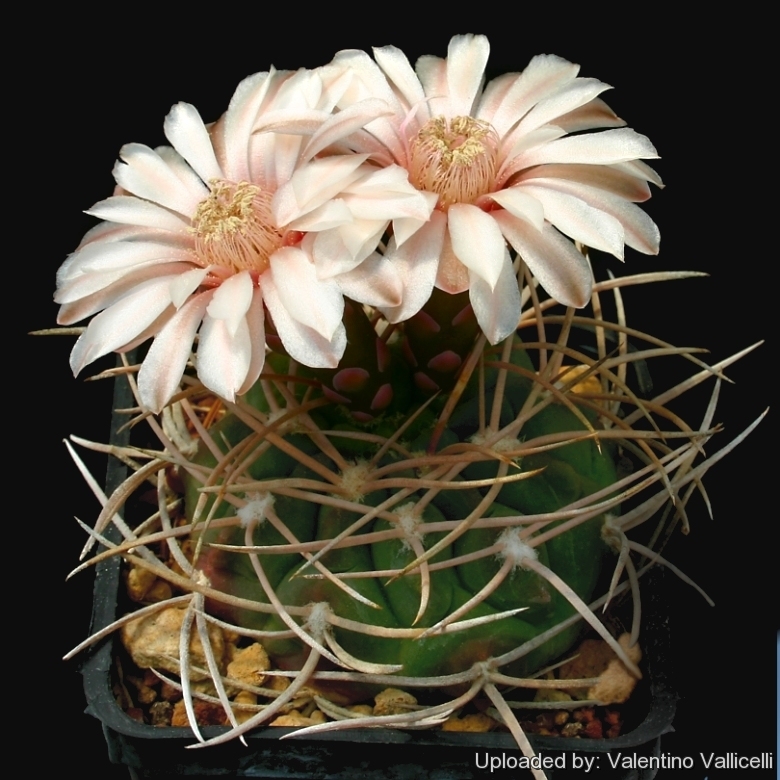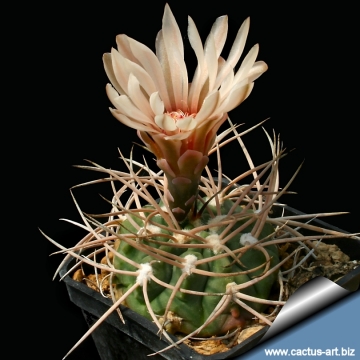Accepted Scientific Name: Gymnocalycium hossei A.Berger
Kakteen (Berger) 226, 341 (1929) et A. W. Hill 1933 (A.Berger)

Gymnocalycium guanchinense Photo by: Valentino Vallicelli
P226 Cuesta Miranda 1500m. Dark green-reddishbody and robust beautiful flower from June to autumn.
Origin and Habitat: Argentina (La Rioja)
Synonyms:
See all synonyms of Gymnocalycium hossei
back
Accepted name in llifle Database:Gymnocalycium hossei A.BergerKakteen (Berger) 226, 341 (1929) et A. W. Hill 1933Synonymy: 18
back
Description: This is a solitary geophytes plant with a swollen underground root system. The plant body has significant chin humps below the large woolly and peculiar areoles. The plants typically got a dark greenish red-violet-brown body colour.
Stem: Up to 15 cm in diameter, dark green to brown flattened with wavy ribs.
Spines: The spines are pale brown extremely curved and long.
Flowers: Near the apex, 70mm in length and 60mm in diameter
Flowering time: Blooms appear recurrently from June to autumn.
Subspecies, varieties, forms and cultivars of plants belonging to the Gymnocalycium hossei group
Bibliography: Major references and further lectures
1) Edward Anderson “The Cactus family” Timber Press, Incorporated, 2001
2) James Cullen, Sabina G. Knees, H. Suzanne Cubey "The European Garden Flora Flowering Plants: A Manual for the Identification of Plants Cultivated in Europe, Both Out-of-Doors and Under Glass" Cambridge University Press, 11/Aug/2011
3) David R Hunt; Nigel P Taylor; Graham Charles; International Cactaceae Systematics Group. "The New Cactus Lexicon" dh books, 2006
4) N. L. Britton, J. N. Rose “The Cactaceae. Descriptions and Illustrations of Plants of the Cactus Family.” Volume 4, The Carnegie Institution of Washington, Washington 1923
5) Curt Backeberg “Die Cactaceae: Handbuch der Kakteenkunde” Gustav Fischer Verlag, Stuttgart New York 1982–1985
6) John Borg “Cacti: a gardener's handbook for their identification and cultivation” Blandford P., 1970
 Gymnocalycium guanchinense Photo by: Cactus Art
Gymnocalycium guanchinense Photo by: Cactus Art Gymnocalycium guanchinense Photo by: Cactus Art
Gymnocalycium guanchinense Photo by: Cactus ArtCultivation and Propagation: Gymnocalycium guanchinenseSN|14403]]SN|14403]] is a summer grower species that is easy to cultivate.
Growth rate: It is a relatively rapidly growing and easily flowering species that will make clumps given the best conditions.
Soils: It likes very porous standard cactus mix soil. Prefer a low pH compost, avoid substrata rich in limestone; otherwise growth will stop altogether.
Repotting: This plant needs plenty of space for its roots, repotting should be done every other year or when the it has outgrown its pot. Use pot with good drainage.
Watering: Needs moderate to copious waterings in summer, but do not overwater (Rot prone), keep dry in winter at a minimum temperature of 0°C.
Fertilization: Feed with a high potassium fertilizer in summer.
Hardiness: Reputedly resistant to frost if kept on the dry side prior to, and during, cold weather (hardy to -12 C ° C, or less for short periods), but for safe cultivation it is best to avoid freezing temperatures.
Exposition: The plant tolerates extremely bright situations but enjoys filtered sunlight or afternoon shade, inside it needs bright light, and some direct sun. Tends to bronze in strong light, which encourages flowering and heavy spine production, but is likely to suffer from sun scorch or stunted growth if over exposed to direct sunlight during the hottest part of the day in summer.
Uses: It is an excellent plant for container growing. It always looks good and stays small. It look fine in a cold greenhouse and frame or outdoor in a rockery.
Pests & diseases: It may be attractive to a variety of insects, but plants in good condition should be nearly pest-free, particularly if they are grown in a mineral potting-mix, with good exposure and ventilation. Nonetheless, there are several pests to watch for:
- Red spiders: Red spiders may be effectively rubbed up by watering the plants from above.
- Mealy bugs: Mealy bugs occasionally develop aerial into the new growth among the wool with disfiguring results, but the worst types develop underground on the roots and are invisible except by their effects.
- Scales: Scales are rarely a problem.
- Rot: This species is particularly easy and accommodating, seldom suffer of cryptogamic diseases. Rot it is only a minor problem with gymnocalyciums if the plants are watered and “aired” correctly. If they are not, fungicides won't help all that much.
Propagation: Division, direct sow after last frost. Seeds germinate in 7-14 days at 21-27° C in spring, remove gradually the glass cover as soon the plants will be well rooted (ca 1-2 weeks) and keep ventilated, no full sun for young plants! To make a cutting twist off a branch and permit it to dry out a couple of weeks, lay it on the soil and insert the stem end partially into the soil. Try to keep the cutting somewhat upright so that the roots are able to grow downward.












